CKBlog: The Market
Tuesday, July 18, 2023
Risk Reversal: 2023 Semi-Annual Review
by The CastleKeep Team
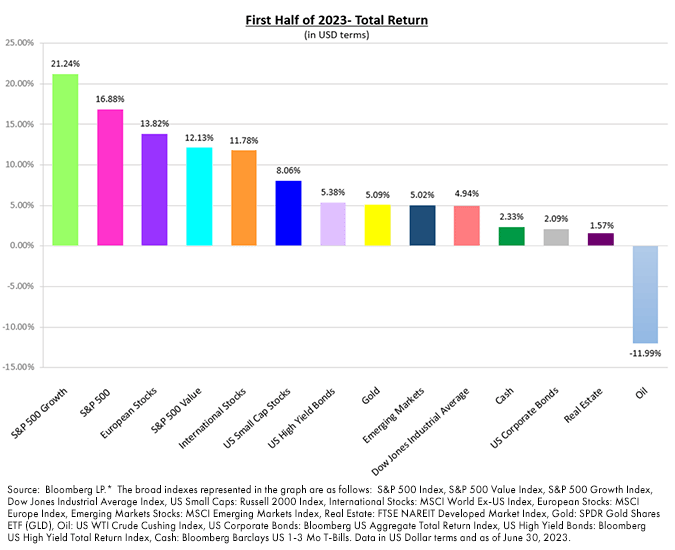
If last year was described as “risk off,” this year can be described as “risk on”—at least through the first half of 2023. It likely caught many market participants off guard. Sentiment was awful at the start of the year. Investors were coming off a year where equity markets dropped nearly 20% and long-dated bond portfolios suffered double-digit losses.
Many individual investors were holding more cash than usual—4% yields were certainly attractive yet they were still anticipating higher interest rates. Professional (hedge fund) investors, with whom we often speak, were lowering their equity exposures and increasing their short exposure—attempting to protect themselves from a continued market sell-off.
In many ways, skepticism made sense coming into 2023. During 2022, the war in the Ukraine was ongoing, inflation remained elevated and the US experienced the most aggressive rate hikes in four decades.
The early part of 2023 saw much of the same as the Fed added three more hikes before deciding to leave rates unchanged in June. See the chart below with rate hikes over the past 18 months:
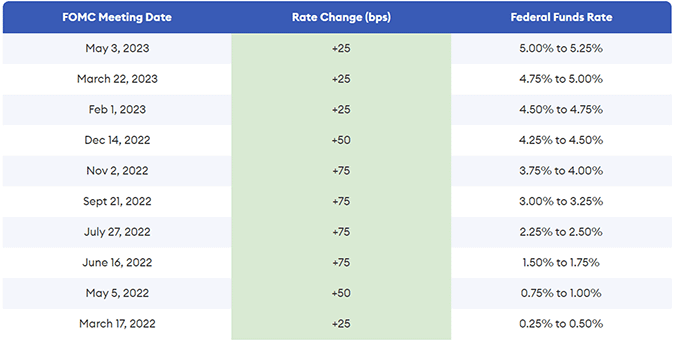
Source: https://www.forbes.com/advisor/investing/fed-funds-rate-history/
There hasn’t been much progress in the Ukraine. The Fed has continued increasing interest rates. So why have most risk assets traded higher this year?
Inflation Moderating
Markets are forward-looking. If one of the most important inputs to investors’ decision making has been the trajectory of inflation, and the resulting activities of the Fed, then the chart below may offer an explanation for the improving sentiment within markets. The monthly year-over-year inflation rate has decreased for 12 consecutive months with the latest reading of CPI coming in at 3.0% in June. To be clear, this means prices are still rising but by much less than the 9.1% we experienced in June of 2022.
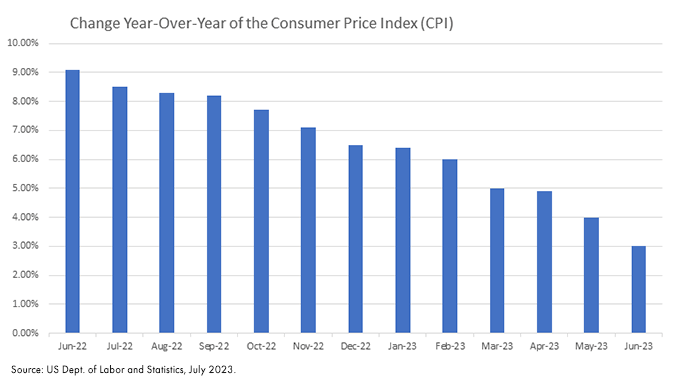
This is a positive sign and has left many investors hopeful that the Fed might be closer to ending their aggressive rate raising regime. However, we don’t yet feel comfortable sending out the “all clear” signal. Professional investors that have lived through periods of high inflation, including our CIO, have been vocal in warning that inflation will be more difficult to tame than most believe. True to form, despite more tepid price increases as of late, Fed Governors have recently indicated they expect one or two more rate hikes this year.
What Recession?
The economy remains strong. Both in the US and abroad. We could list countless anecdotes (full flights, expensive hotels, lack of inventory for cars and homes) but economic data also indicate that most economies, including the US, continue to grow. According to the Bureau of Economic Analysis, US GDP grew at an annual rate of 2.6% in Q4 2022 and by 2.2% in Q1 2023. The Atlanta Fed’s GDPNow estimate for Q2 growth just increased from 2.1% to 2.3% on July 10.
The labor market also remains strong. June’s reading of unemployment was 3.6%, just a few tenths of one percent off the record low set earlier this year.
Consumer spending, which makes up roughly 70% of the US economy, is at record highs after a steep rebound post COVID. See below the 10-year chart of Personal Consumption from the St. Louis Fed.
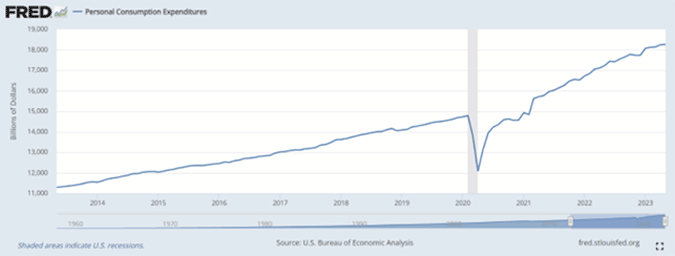
The trend can change at any point, and the data we referenced is backward-looking, but for now, there’s no clear evidence of a recession in the near term. A strong economy buoyed by low unemployment and continued fiscal stimulus, combined with the recent trend of lower inflation, has given confidence to equity and fixed income investors.
Caught Offsides
We touched upon negative sentiment resulting in lower equity exposures for both individual and professional investors early in the year betting that the weakness in markets during 2022 would spill over to 2023. As we now know, the opposite was true. Note the S&P 500 Index total returns by month to start the year:

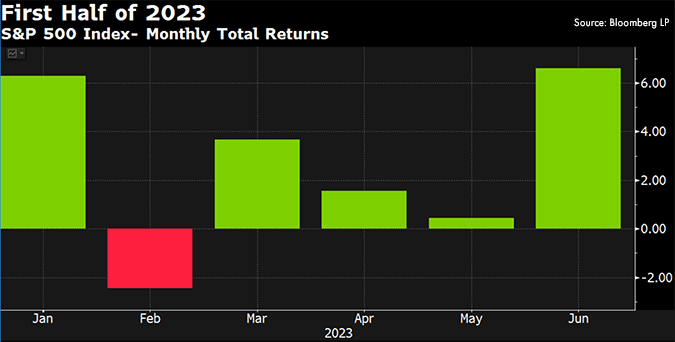
With stocks off to a hot start, some professional money managers had to reverse course and increase their exposure to stocks—perhaps some of whom were engaging in window-dressing before quarter end. A large increase in fund flows to stocks helped buoy an already strong market. Hedge fund managers aren’t immune to the fear of missing out either…
NOTABLE EVENTS
After covering the macro backdrop, we’d like to spend some time addressing notable events that have taken place so far this year.
Bank Crisis?
Many analysts have long said that the Fed would continue raising rates until “something breaks.” In March, three large banks “broke:” Silicon Valley Bank, First Republic Bank, and Signature Bank. The Signature Bank failure was attributed to their focus on the crypto industry. Silicon Valley and First Republic were classic examples of bank runs and a mismatching of deposits against bank assets (often times long-dated bonds).
The largest to go was Silicon Valley Bank with a $16 billion market cap just two days before it failed. The Bank had long been lauded for providing top level services and competitive lending to venture capitalists and their portfolio companies. It seemed like a reasonable business plan until it became apparent that Bank management didn’t match the duration of their deposits (considered a short-term liability as customers can withdraw funds at any time) with their portfolio of assets (long-dated bonds and loans which suffered steep unrealized losses as interest rates moved higher).
While several analysts sounded the alarm on the Bank’s lack of proper risk management, it wasn’t until a handful of influential venture capitalists, who curiously also happened to be large customers of the Bank, publicly advised their portfolio companies to move funds out of Silicon Valley Bank due the apparent risk of insolvency. In a matter of days, the FDIC stepped in, took over the Bank, and negotiated a sale to Raleigh, NC based First Citizen’s Bank. Equity holders were wiped out.
2023’s version of a “banking crisis” was upon us. Well-regarded First Republic Bank, who catered to the ultra-wealthy in New York, Boston, and California, was next to be taken over after public markets realized management also mismatched their assets and liabilities. JP Morgan took over most of the bank after the FDIC stepped in.
For weeks, rumors circulated about who was next to fall. Bank stocks tumbled, then stabilized. We wrote about the environment surrounding banks at the time, advising investors that the banking sector remained well capitalized and strong. [Blog post: Bank Stocks Swoon]
We continue to believe banks, in general, offer attractive investment opportunities. As of June 30th, 2023, the SPDR S&P Bank ETF (Ticker KBE) sported a roughly 4% dividend yield, traded at a forward Price-to-Earnings ratio of 7.7 (more than 50% discount to the S&P 500 Index P/E), and a Price-to-Book ratio of 0.94. A P/B ratio below one means if an investor took all banks in the index, sold off all of their assets and paid off all of their liabilities, they’d be left with cash in hand. If banks in general continue to grow earnings, this may be a classic example of Ben Graham and Warren Buffett’s “Margin of Safety.”
Debt Ceiling Debacle
If the war in the Ukraine, rising interest rates and bank failures weren’t enough to worry about, the US Congress threw more fuel on the fire by allowing debt ceiling negotiations to last through to the eleventh hour. It may seem like forever ago, but this was the focus of both Wall Street and Main Street for some time. We heard from several clients who were very concerned about the implications of a default by the US Government. Understandably, some even asked whether it was safer to hold physical cash over T-Bills in a brokerage account.
While there was no guarantee that an agreement would be reached to increase the debt limit and avoid a default, we were confident that even the most inept representatives would resolve the issue. And they did ... eventually.
It’s important to remember that this likely will happen again. And just because the deadline to raise the debt ceiling in future years may expire, it doesn’t necessarily mean the US Government automatically defaults on all of their obligations—including interest and principal payments on US Treasury Bills, Notes, and Bonds.
We witnessed this in August of 2011. While the failure of resolution of the debt ceiling did cause volatility in equity and bond markets, Treasury Obligations were honored. The US Government was wise enough to cut spending and government contracts on non-essential items rather than risk the loss of its full faith and credit.
We will see this again. When we do, don’t panic.
Market Cap Weighted Versus Equal Weighted S&P 500
If you have been following the equity markets this year, you know that the S&P 500 Index (market cap weighted) has been driven mainly by its top seven companies by market cap (the so-called “Magnificent Seven”). Through June 30th, the total return of the seven largest companies in the index is as follows:
![]()
Before you kick yourself for not just going with the top seven, the same companies had the following total return for 2022:
![]()
What if you picked the wrong year to go “all in” on the biggest of stocks? Would you have stuck with your picks after such steep losses 2022? Remember, after a 50% drop, you have to earn 100% to break even. So don’t kick yourself.
We recognize that the traditional S&P 500 Index return of 16.88% through June 30th was driven primarily by the top seven, but investors shouldn’t dismiss the overall market performance altogether. The average stock is doing well. The Equal Weighted S&P 500 Index (Ticker SPW), where each company represents the same weighting within the index, had a total return of 7.02% through June 30 of this year. Don’t be fooled by the headlines, 2023 has ushered in a broad market rally.
International Stocks?
Don’t forget international equities. Yes, the war in the Ukraine continues raging and there are increased tensions between the US and China, but for the six months ending June 30, the MSCI All World Ex-US Index was up 9.86% (including dividends), the MSCI Europe Index was up 13.82% in USD terms. Even the MSCI Emerging Market Index was up 5.02% in USD terms. We have been in the midst of a global equity market rally.
US T-Bills Competing With Stocks
As we entered into this year, we were hearing more and more from clients about how attractive short-term rates had become. And we agreed. For the first time in over a decade, cash held by portfolios actually contributed to performance.
With sentiment so low, it was no wonder why clients were wondering if earning an annualized yield of 4-5% by owning short-dated US T-Bills offered a more attractive opportunity than a portfolio of stocks. It seemed like a reasonable premise, and for many clients with short-term objectives owning a portfolio of US T-Bills made sense.
Consider you had a pool of $100,000 to put to work on January 1st, 2023. You had at least two basic options:
A. Invest $100,000 in one year US T-Bills paying you a guaranteed annualized return of at least 4% (assuming the US Government didn’t collapse).
B. Invest $100,000 in an S&P 500 Index fund such as ticker SPY.
Go back to January 1. Which would you have chosen? I’d argue most investors would have chosen Option A given the sentiment at the time. How would it have turned out?
On June 30, 2023, Option A would be worth roughly $102,000 (you earned ½ of the 4% annualized yield on the T-Bills).
Option B would be worth roughly $116,790 (SPY had a total return of 16.79%).
Markets have a habit of humbling us all. We are glad that, so far this year, most of us have been humbled while earning decent returns.
And don’t forget that the underlying inflation rate year-over-year was higher than the US Treasury Bill rate, albeit falling. Over the last 12 months, investors who put their money in short-term US Treasury Bills lost money after subtracting inflation and taxes.
CastleKeep Is Growing Too
Financial markets weren’t the only things growing this year. In February, we were thrilled to announce two new partners at CastleKeep.
Lauren Quesada, who joined CastleKeep as an intern 12 years ago, was appointed as a Partner of the firm on January 1. We are proud of her growth and the positive impact she has had on client portfolios. Lauren has always been an integral part of our investment team, but we are excited to also have her join the partnership.
Mike Benevento joined CastleKeep on February 1 of this year as Partner after a multi-decade career as a hedge fund manager, most recently with Millenium Management. Mike is not only a skilled investor and teacher (having taught at Columbia Business School, Notre Dame, and Bucknell) but is most excited about being able to have a direct impact on clients’ lives. For more about Mike’s decision to join CastleKeep, please read his recent blog post: Why CastleKeep? Why Now?
We are committed to building a world-class firm with small town values. Lauren and Mike joining our partnership is further evidence of this commitment.
We thank our clients for their trust and confidence and wish for a prosperous and healthy rest of 2023 (and beyond).
Sincerely,
The CastleKeep Team
July 18, 2023
Click to download a PDF of “Risk Reversal: 2023 Semi-Annual Review”




